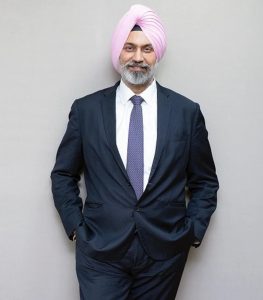https://www.freepressjournal.in/business/satin-creditcare-is-better-off-in-covid-19-times-due-to-rural-presence-says-h-p-singh
Interview -H P Singh -Satin Creditcare
Microfinance has been doing well in these times
By Jescilia Karayamparambil & RN Bhaskar — Sept 4, 2020
 A law graduate and fellow of The Institute of Chartered Accountants of India, H P Singh, has come a long way since he first set his foot into the microfinance space. Singh, Chairman and Managing Director of Satin Creditcare Network Limited (SCNL), has been in this space for over three decades now. Ditto with SCNL.
A law graduate and fellow of The Institute of Chartered Accountants of India, H P Singh, has come a long way since he first set his foot into the microfinance space. Singh, Chairman and Managing Director of Satin Creditcare Network Limited (SCNL), has been in this space for over three decades now. Ditto with SCNL.
Today, his company’s assets under management (AUM) stand at Rs 8,119 crore (FY 2021), a growth of 14 per cent compared to the last year. Due to a strong presence in rural India, Singh is optimistic that the path of recovery will be faster for his company compared to urban-based microfinance companies, post a complete lift of the COVID-19-induced lockdown restrictions.
In an interview with Free Press Journal’s Jescilia Karayamparambil and R N Bhaskar, Singh talks about the position of microfinance institutions (MFIs) during COVID-19 times.
Given below are edited excerpts:
How has your journey been?
My journey began in the 90s. I borrowed money from my retired father to set up this business. Banks were reluctant to lend to potential borrowers in no-go areas. One such area was Delhi East. I began lending money to small shopkeepers for purchasing gensets. Unlike banks, I collected the EMI daily. There were no delinquencies, and I recovered the money in three months. Then we began financing purchases of two-wheelers. This time, I took a line of credit from vehicle manufacturers. And, thus, the business kept growing.
Hailing from a family with no background in business, it was altogether a different experience. Finally, in 1996 we decided to float an IPO (initial public offering), and in 2005 we took a line of credit from SIDBI. We have grown a lot since then.
Today on a consolidated basis, we are around 8,119 crore, in terms of our AUM (assets under management). In terms of branch penetration, we have around 1,350 branches. We are present in 23 states and Union Territories. We cater to 32 lakh families. And, we have close 10,000 employees.
While we started as an urban finance company but today, we have 80 per cent presence in rural India. We cover around 90,000 villages in the country today.
COVID-19 has hurt the industry. So, how do you see your position at this time?
This is where the difference between the urban and rural divide comes into play. The pandemic has hurt the urban economy much more than the rural economy. Agriculture and its allied activities are doing much better this year compared to last year. So, the prices of essential commodities like crops and dairy have not been hit.
There is more traction in loan repayments in the rural economy. Only 11 per cent of our borrowers have taken the moratorium option. Meanwhile, the remaining 89 per cent of our borrowers have repaid one or more than one installments. This means the cash flow of the borrowers in the rural area has not been impacted by the pandemic, the way it has impacted urban dwellers.
Around 80 per cent of our portfolio is directly rural and the remaining 20 per cent is semi-urban which has fringes of rural in it.
Which means you do not fear delinquencies the way urban lenders may face?
There is a sharp difference in the way urban and rural lenders will look at this pandemic. The delinquencies will be slightly higher in the urban area rather than in the rural area.
In the rural sector, farmers are honest people who pay their dues. But politicians have corrupted the atmosphere through loan waivers among other things. What is your take?
If there were no politicians, then the microfinance institutions in the country would not have seen what they have witnessed (those bad days). It is only due to the politicians — who do not look at the interest of the borrower, but at ways to gain votes — that MFIs are in such a position.
The policymakers fail to understand that the penetration that MFIs can achieve is much more than what banks would have been able to achieve. There are very few institutions in the country that can service 90, 000 villages.
How did you cope with moneylenders in these regions?
Moneylenders still exist. But they only gain momentum when the local politicians gang up and say that we do not want these MFIs.
In the case of Andhra Pradesh, after the SKS controversy (when microfinance companies were compelled to shut shop), borrowers did not have any option left (but to go to moneylenders). All MFIs and other such institutions had to exit that market. The state had introduced legislation as well. Usually, in such a case, the money lenders must have already made a huge amount of money by lending.
Now farmers want MFIs back because they do not want to pay the high charges moneylenders demand.
Thus, the moneylender and MFIs will co-exist. But the hold of these money lenders has faded to a large extent in some areas.
What is your wish list for the government?
The government should encourage a change in perception of MFIs. Even today, despite doing all that we have done, the government does not recognise or give us the status that the industry deserves. The perception of the government, bureaucracy, and lenders is flawed (and unsympathetic) towards MFIs.
MFIs help the under-banked to rise in their lives.
For instance, we have financed 1.12 lakh households in Bihar to build toilets. After building toilets, they approached us to help finance them in building bathrooms. But when we tell the bureaucrats this, they tell us that we levy interest.
Despite lending for socially relevant activities, we are looked down upon. Thus, such perceptions must change.
If this falls into place, the rest will follow.
Would you look at artificial intelligence to improve the business?
Technologically, SCNL is advanced. For instance, we have an app for our customers. KYC is digitally loaded. All the money which we disburse to our clients goes to their bank accounts. No cash is involved.
Artificial intelligence will come up slowly and steadily. As of now, all of these borrowers are on the credit bureau score.
We are strengthening ourselves on the AI and digital fronts. It is not far when everything will take place over the phone.
Tell us about your Pragati loan?
This loan has been specifically designed for COVID-19 times. This is mainly for borrowers whose income generation activity has been impacted. They will be given a fresh loan, alongside their existing loan.
What is the time frame that you are looking at for normalisation in business?
It is not completely normal today. With Unlock-4 happening, I think it will take two months from now for things to stabilise and normalcy to return, provided there is no fresh spike in infections.
Business is not, as usual, today but we are optimistic things will pick up sooner.
What is the level of infection risk involved in the areas where SCNL centres and branches are located?
The usual meetings are not taking place in our centres any more. Most of our staff visit the homes of the borrowers, plus there is some level of cashless transactions also taking place through our app. So, we are trying to reduce the level of risk among our staff. All our staff have COVID-19 insurance covers. We are supplying masks and sanitisers as precautionary measures to our staff and also to some of our borrowers (under CSR).
In fact, out of the 10,000 employees only around 8-10 got infected.
Has there been a major layoff in the MFIs sector?
There have been no layoffs. But there are families of these staffers who do not wish to send their family members to far off locations — this has restricted the movement of existing employees. However, there have been no layoffs and hiring. In the case of hiring additional staff, there is a need to have a little more stability.
How is the position of your collections and liquidity?
Our collection efficiency stands at 85-86 per cent during COVID-19 times.
Our liquidity position is very good. We have got funds under a special liquidity scheme, Targeted Long Term Repo Operations (TLTRO) and partial credit guarantee schemes.
We have enough liquidity to service our liabilities. As per the conservative estimate, we would be able to service our liabilities for the next 12 months.
Would that mean you will not go for any funding raising exercise?
True, we will not. We have enough liquidity.







































COMMENTS